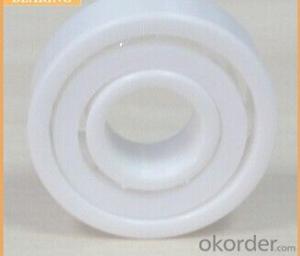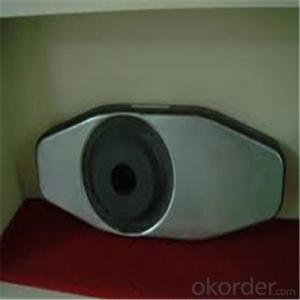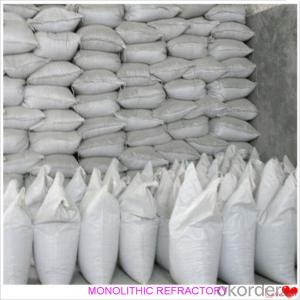Monolithic Refractories for Iron and Steel Industry High Performance Ceramic Ball Bearing
- Loading Port:
- Qingdao
- Payment Terms:
- TT OR LC
- Min Order Qty:
- 500 pc
- Supply Capability:
- 2000 pc/month
OKorder Service Pledge
Quality Product, Order Online Tracking, Timely Delivery
OKorder Financial Service
Credit Rating, Credit Services, Credit Purchasing
You Might Also Like
Specifications
Ceramic Ball Bearing
1,Low noise
2,Competitive Price
3,Quick Delivery,Good Service
4,ISO9001:2000
.Full ceramic bearing made with ZrO2 have excellent performance as special electrical and magnetism,wear and corrsion resistance,lubrication and maintance free when working,especiall high and low-temperature application,etc.,could be used in awful environment and specially condition,
2.The rings and balls: full ceramic materia:ZrO2
- Q: How do monolithic refractories contribute to the overall efficiency of iron and steel production?
- Monolithic refractories play a crucial role in enhancing the overall efficiency of iron and steel production. These refractories, which are made from a single material, provide exceptional thermal insulation, resistance to high temperatures, and excellent mechanical strength. By lining the furnaces, ladles, and other equipment used in the production process, monolithic refractories help in maintaining and regulating the required high temperatures for melting, refining, and shaping iron and steel. This insulation reduces heat loss, minimizes energy consumption, and ensures a more efficient and cost-effective production process. Additionally, the mechanical strength of monolithic refractories allows for better protection against wear and tear, resulting in increased equipment lifespan and reduced downtime for repairs and maintenance. Overall, the use of monolithic refractories significantly contributes to the efficiency, productivity, and sustainability of the iron and steel production industry.
- Q: What types of monolithic refractories are commonly used in the iron and steel industry?
- Commonly used monolithic refractories in the iron and steel industry include castables, gunning mixes, and ramming mixes.
- Q: What are the factors influencing the choice of monolithic refractories for different furnace types?
- There are several factors that influence the choice of monolithic refractories for different furnace types. Firstly, the operating temperature of the furnace is a crucial factor as different monolithic refractories have different temperature resistance levels. Secondly, the type of material being processed in the furnace is important as certain materials may require specific refractories to withstand their corrosive or abrasive nature. Thirdly, the furnace design and its heating method also play a role in determining the suitable refractory material. Additionally, the thermal conductivity, thermal shock resistance, and mechanical strength of the refractory are considered to ensure optimal performance and durability. Finally, cost, availability, and installation requirements are factors that can influence the choice of monolithic refractories for different furnace types.
- Q: How do monolithic refractories resist chemical attacks from molten metals and slag?
- Monolithic refractories are specifically designed to resist chemical attacks from molten metals and slag. They possess several key characteristics that enable them to withstand these aggressive environments. Firstly, monolithic refractories are composed of high-quality materials that have excellent chemical resistance. These materials, such as alumina, magnesia, and chrome, have a high melting point and are stable even when exposed to extreme temperatures and corrosive substances. This chemical stability ensures that the refractory can maintain its integrity and structural strength when in contact with molten metals and slag. Secondly, monolithic refractories have a dense and compact structure. This microstructure helps to prevent the penetration of molten metals and slag into the refractory material. The dense structure acts as a barrier, limiting the contact between the corrosive substances and the refractory. This reduces the chances of chemical reactions and erosion, thereby enhancing the resistance of the refractory to chemical attacks. Furthermore, monolithic refractories often contain additives and binders that enhance their chemical resistance. These additives create a protective layer on the refractory surface, acting as a shield against chemical attacks. They can also react with certain corrosive substances, forming stable compounds that further resist the penetration and corrosion of the refractory material. Additionally, monolithic refractories are designed to have low porosity. This low porosity minimizes the absorption of molten metals and slag, preventing them from infiltrating the refractory and causing damage. By reducing the permeability of the material, the refractory can maintain its structural integrity and resist chemical attacks over prolonged periods. In conclusion, monolithic refractories resist chemical attacks from molten metals and slag through their high-quality materials, dense structure, additives, and low porosity. These combined properties allow the refractories to withstand aggressive environments and maintain their performance and longevity in industrial applications.
- Q: How do monolithic refractories enhance the performance of ladle and tundish preheating systems?
- Monolithic refractories enhance the performance of ladle and tundish preheating systems by providing excellent thermal insulation, high mechanical strength, and resistance to corrosion and erosion. This allows for efficient heat retention and distribution, ensuring uniform and consistent preheating of ladles and tundishes. Additionally, monolithic refractories minimize heat losses, reduce energy consumption, and increase the lifespan of the preheating systems, contributing to improved overall performance.
- Q: What are monolithic refractories and how are they different from other refractory materials?
- Monolithic refractories, unlike bricks or tiles, are refractory materials that are not pre-formed into specific shapes or sizes. Instead, they are composed of a mixture of aggregates, binders, and additives, which are then installed and cured to create a solid and dense structure. One notable difference between monolithic refractories and other refractory materials is their versatility and ease of installation. While traditional bricks or tiles require skilled labor and careful assembly, monolithic refractories can be poured, sprayed, or gunned into place, allowing for a faster and more efficient installation process. This makes them particularly suitable for complex shapes or hard-to-reach areas. Another distinction lies in the physical properties of monolithic refractories. Unlike bricks and tiles, which are known for their mechanical strength and resistance to thermal shock, monolithic refractories can be customized to exhibit a wide range of properties. Depending on the specific application requirements, they can be engineered to have excellent thermal insulation, superior corrosion resistance, or enhanced abrasion resistance. This adaptability makes monolithic refractories suitable for various industries, including steel, cement, glass, and petrochemical. Furthermore, monolithic refractories have the advantage of being able to expand and contract with temperature changes, unlike rigid brick structures. This thermal flexibility helps prevent cracking and damage caused by thermal cycling, thus prolonging the lifespan of the refractory lining. Additionally, monolithic refractories offer better refractory integrity and reduced joint failure since they do not have seams or weak points that are susceptible to thermal stresses. In conclusion, monolithic refractories are a versatile and convenient type of refractory material that can be tailored to meet specific application requirements. Their easy installation, thermal flexibility, and customizable properties distinguish them from other refractory materials like bricks or tiles.
- Q: Can monolithic refractories be customized for specific iron and steel processing requirements?
- Indeed, monolithic refractories possess the capability to be personalized in order to satisfy the distinct demands of iron and steel processing. Renowned for their adaptability and versatility, monolithic refractories can be tailored to accommodate a wide range of applications. The formulation, tangible characteristics, and methods of installation can all be modified to cater to the specific necessities of iron and steel processing. For instance, the selection of raw materials employed in the production of monolithic refractories can be customized to endure the formidable temperatures and harsh chemical environments inherent in iron and steel processing. Diverse types of aggregates, binders, and additives can be chosen to augment the refractory's resistance against thermal shock, erosion, and corrosion. Moreover, the installation technique for monolithic refractories can be adjusted to suit the precise requirements of iron and steel processing. Whether it is gunning, casting, ramming, or spraying, the method of installation can be personalized to guarantee optimal performance and durability in the given application. Additionally, monolithic refractories can also be tailored to particular shapes and sizes to accommodate the various equipment and structures utilized in iron and steel processing. This facilitates a more precise and efficient lining of furnaces, ladles, tundishes, and other vessels, thereby enhancing overall productivity and performance in the process. In conclusion, monolithic refractories can be customized to cater to the distinct requirements of iron and steel processing by modifying their composition, tangible characteristics, installation techniques, and shape. This customization ensures that the refractories can withstand the extreme conditions encountered in these industries, resulting in improved performance, prolonged service life, and enhanced productivity.
- Q: How are monolithic refractories manufactured?
- Monolithic refractories are manufactured by combining various raw materials, such as aggregates, binders, and additives, with water to create a workable mixture. This mixture is then shaped into the desired form, either by casting, gunning, or ramming. Afterwards, the shaped refractory is dried and fired at high temperatures to achieve the desired strength and thermal properties. The manufacturing process of monolithic refractories allows for flexibility in design and installation, making them suitable for a wide range of applications.
- Q: What are the recommended storage and handling practices for monolithic refractories?
- The recommended storage and handling practices for monolithic refractories include storing them in a dry and covered area to prevent moisture absorption, avoiding direct contact with the ground to prevent contamination, and ensuring proper ventilation to prevent condensation. It is important to handle them with care, avoiding dropping or hitting them, and using appropriate lifting equipment when necessary. Additionally, following the manufacturer's guidelines for installation, curing, and drying processes is crucial to ensure optimal performance and longevity of the monolithic refractories.
- Q: What are the factors affecting the lifespan of monolithic refractories?
- There are several factors that can significantly affect the lifespan of monolithic refractories. 1. Temperature: One of the most critical factors is the operating temperature. Monolithic refractories are designed to withstand high temperatures, but prolonged exposure to extreme temperatures can cause thermal shock and lead to premature failure. 2. Thermal cycling: Frequent temperature fluctuations, known as thermal cycling, can also shorten the lifespan of monolithic refractories. The expansion and contraction of the refractory material can create stress, resulting in cracking and degradation over time. 3. Chemical environment: The chemical environment in which the monolithic refractories are used plays a crucial role in their lifespan. Exposure to corrosive gases, acids, alkalis, or molten metals can cause chemical reactions that degrade the refractory material. 4. Mechanical stress: Mechanical stress, such as abrasion, impact, and vibration, can weaken monolithic refractories and shorten their lifespan. This is especially relevant in industries with high mechanical activity, such as steelmaking or cement production. 5. Installation and maintenance: Proper installation and regular maintenance are essential for maximizing the lifespan of monolithic refractories. Poor installation techniques or neglecting maintenance can result in weak joints, inadequate anchoring, or the growth of cracks, leading to premature failure. 6. Quality of refractory material: The quality and composition of the monolithic refractory material can significantly impact its lifespan. Higher-quality materials with better resistance to temperature, chemical attacks, and mechanical stress tend to have longer lifespans. 7. Design and engineering: The design of the refractory lining and its engineering considerations, such as thickness, shape, and reinforcement, also influence the lifespan of monolithic refractories. Proper design can distribute stress more evenly, reduce thermal gradients, and improve overall performance and durability. 8. Operating conditions: The way monolithic refractories are operated and handled can affect their lifespan. Factors such as rapid temperature changes, improper cooling or heating procedures, or excessive thermal cycling can all contribute to premature failure. In summary, the lifespan of monolithic refractories is influenced by various factors, including temperature, thermal cycling, chemical environment, mechanical stress, installation and maintenance practices, quality of refractory material, design and engineering considerations, and operating conditions. Proper consideration and management of these factors are essential for maximizing the lifespan of monolithic refractories.
Send your message to us
Monolithic Refractories for Iron and Steel Industry High Performance Ceramic Ball Bearing
- Loading Port:
- Qingdao
- Payment Terms:
- TT OR LC
- Min Order Qty:
- 500 pc
- Supply Capability:
- 2000 pc/month
OKorder Service Pledge
Quality Product, Order Online Tracking, Timely Delivery
OKorder Financial Service
Credit Rating, Credit Services, Credit Purchasing
Similar products
Hot products
Hot Searches
Related keywords

























